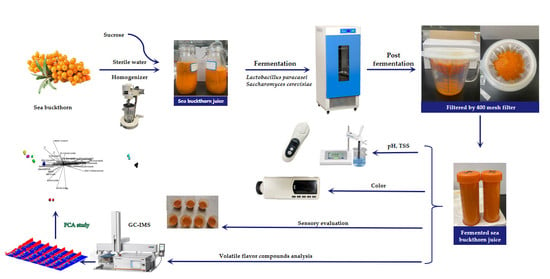Changes of Volatile Flavor Compounds in Sea Buckthorn Juice during Fermentation Based on Gas Chromatography–Ion Mobility Spectrometry
Abstract
1. Introduction
2. Materials and Methods
2.1. Materials
2.2. Fermentation Treatment
2.3. pH and TSS
2.4. Color
2.5. Sensory Evaluation
2.6. Identifification of Flavor Compounds by GC–IMS
2.7. Statistical Analysis
3. Results and Discussion
3.1. pH and TSS Changes in Sea Buckthorn Juice during Fermentation
3.2. Color Changes in Sea Buckthorn Juice during Fermentation
3.3. Sensory Changes in the Sea Buckthorn Juice during Fermentation
3.4. Volatile Substances Changes in the Sea Buckthorn Juice during Fermentation
3.4.1. GC–IMS Analysis for Characteristic Peak of Volatile Flavor Compounds during Sea Buckthorn Juice Fermentation
3.4.2. Identification of Volatile Flavor Compounds in the Sea Buckthorn Fermented Juice
3.4.3. Principal Component Analysis (PCA) of the Characteristic Flavor Compounds Present in the Sea Buckthorn Juice during Fermentation
4. Conclusions
Supplementary Materials
Author Contributions
Funding
Institutional Review Board Statement
Informed Consent Statement
Data Availability Statement
Acknowledgments
Conflicts of Interest
References
- Kumar, A.; Kumar, P.; Sharma, A.; Sharma, D.P.; Thakur, M. Scientific insights to existing know-how, breeding, genetics, and biotechnological interventions pave the way for the adoption of high-value underutilized super fruit sea buckthorn (Hippophae rhamnoides L.). S. Afr. J. Bot. 2022, 145, 348–359. [Google Scholar] [CrossRef]
- Ao, X.; Mu, Y.; Xie, S.; Meng, D.; Zheng, Y.; Meng, X.; Lv, Z. Impact of UHT processing on volatile components and chemical composition of sea buckthorn (Hippophae rhamnoides) pulp: A prediction of the biochemical pathway underlying aroma compound formation. Food Chem. 2022, 390, 1331242. [Google Scholar] [CrossRef] [PubMed]
- Sadowska, B.; Budzynska, A.; Stochmal, A.; Zuchowski, J. Novel properties of Hippophae rhamnoides L. twig and leaf extracts-antivirulence action and synergy with antifungals studied in vitro on Candida spp. model. Microb. Pathog. 2017, 107, 372–379. [Google Scholar] [CrossRef] [PubMed]
- Sanwal, N.; Mishra, S.; Sahu, J.K.; Naik, S.N. Effect of ultrasound-assisted extraction on efficiency, antioxidant activity, and physicochemical properties of sea buckthorn (Hippophae salicipholia) seed oil. LWT Food Sci. Technol. 2022, 153, 112386. [Google Scholar] [CrossRef]
- Tkacz, K.; Chmielewska, J.; Turkiewicz, I.P.; Nowicka, P.; Wojdyło, A. Dynamics of changes in organic acids, sugars and phenolic compounds and antioxidant activity of sea buckthorn and sea buckthorn-apple juices during malolactic fermentation. Food Chem. 2020, 332, 127382. [Google Scholar] [CrossRef]
- Tanwar, H.; Shweta; Singh, D.; Singh, S.B.; Ganju, L. Anti-inflammatory activity of the functional groups present in Hippophae rhamnoides (sea buckthorn) leaf extract. Inflammopharmacology 2018, 26, 291–301. [Google Scholar] [CrossRef]
- Zhao, L.; Li, M.; Sun, K.; Su, S.; Geng, T.; Sun, H. Hippophae rhamnoides polysaccharides protect IPEC-J2 cells from LPS-induced inflammation, apoptosis and barrier dysfunction in vitro via inhibiting TLR4/NF-κB signaling pathway. Int. J. Biol. Macromol. 2020, 155, 1202–1215. [Google Scholar] [CrossRef]
- National Pharmacopoeia Commission. Pharmacopoeia of the People’s Republic of China; China Medical Science and Technology Press: Beijing, China, 2020; p. 192. [Google Scholar]
- Nawaz, M.A.; Khan, A.A.; Khalid, U.; Buerkert, A.; Wiehle, M. Superfruit in the niche-underutilized sea buckthorn in gilgit-baltistan, Pakistan. Sustainability 2019, 11, 5840. [Google Scholar] [CrossRef]
- Wang, N.; Zheng, W.; Zhang, K.; Wen, X.; Lu, S.; Yang, Z. Research progress on chemical constituents and pharmacological activities of sea buckthorn and prediction of its Q-markers. China J. Chin. Mater. Med. 2021, 21, 5522–5532. [Google Scholar]
- Yang, H.; Wu, D.; Guo, D.; Lu, J. The aromatic volatile composition of Lonicera edulis wines produced with three different strains of Saccharomyces cerevisiae. J. Inst. Brew. 2019, 125, 100–109. [Google Scholar] [CrossRef]
- Lgrr, A.; Vmzg, B.; Mp, A.; Cvna, C.; Fm, A.; Jasb, B. Fruits and fruit by-products as sources of bioactive compounds. Benefits and trends of lactic acid fermentation in the development of novel fruit-based functional beverages. Food Res. Int. 2021, 140, 109854. [Google Scholar]
- Feng, L.; Tang, N.; Liu, R.; Nie, R.; Chang, M. Effects of different processing methods on bioactive substances and antioxidation properties of Lycium barbarum (goji berry) from China. Food Biosci. 2021, 42, 101048. [Google Scholar] [CrossRef]
- Markkinen, N.; Laaksonen, O.; Yang, B. Impact of malolactic fermentation with Lactobacillus plantarum on volatile compounds of sea buckthorn juice. Eur. Food Res. Technol. 2021, 247, 719–736. [Google Scholar] [CrossRef]
- Peng, W.; Meng, D.; Yue, T.; Wang, Z.; Gao, Z. Effect of the apple cultivar on cloudy apple juice ferment ed by a mixture of Lactobacillus acidophilus, Lactobacillus plantarum, and Lactobacillus fermentum. Food Chem. 2021, 340, 127922. [Google Scholar] [CrossRef]
- Zhang, E.; He, P.; Liu, P.; Jian, Y.; Chen, R.; Xu, Y.; Lu, Y.; Luo, Z. Fermentation characteristics for flavor compounds production by yeast strains isolated from Tibet hippophaer rhamnoides. Food Sci. 2022, 1, 1–13. Available online: https://kns.cnki.net/kcms/detail/11.2206.TS.20220321.1613.014.html (accessed on 1 September 2022). (In Chinese).
- Zhang, Y.; Liu, W.; Wei, Z.; Yin, B.; Man, C.; Jiang, Y. Enhancement of functional characteristics of blueberry juice fermented by Lactobacillus plantarum. LWT Food Sci. Technol. 2021, 139, 110590. [Google Scholar] [CrossRef]
- Schubertová, S.; Krepsová, Z.; Janotková, L.; Potočňáková, M.; Kreps, F. Exploitation of Sea Buckthorn Fruit for Novel Fermented Foods Production: A Review. Process. 2021, 9, 749. [Google Scholar] [CrossRef]
- Tiitinen, K.; Vahvaselkä, M.; Hakala, M.; Laakso, S.; Kallio, H. Malolactic fermentation in sea buckthorn (Hippophaë rhamnoides L.) juice processing. Eur. Food Res. Technol. 2005, 222, 686–691. [Google Scholar] [CrossRef]
- Maftei, N.-M.; Aprodu, I.; Dinică, R.; Bahrim, G. New fermented functional product based on soy milk and sea buckthorn syrup. CyTA J. Food 2013, 11, 256–269. [Google Scholar] [CrossRef]
- Negi, B.; Dey, G. Effects of co-fermentation by Saccharomyces cerevisiae and Issatchenkia orientalis on sea buckthorn juice. Int. J. Food Sci. Nutr. 2013, 64, 508–513. [Google Scholar] [CrossRef]
- Cai, W.; Tang, F.; Zhao, X.; Guo, Z.; Zhang, Z.; Dong, Y.; Shan, C. Different lactic acid bacteria strains affecting the flavor profile of fermented jujube juice. J. Food Process. Preserv. 2019, 43, e14095. [Google Scholar] [CrossRef]
- Chen, C.; Zhao, S.; Hao, G.; Yu, H.; Tian, H.; Zhao, G. Role of lactic acid bacteria on the yogurt flavour: A review. Int. J. Food Prop. 2017, 20 (Suppl. S1), S316–S330. [Google Scholar] [CrossRef]
- Yan, Y.; Sun, L.; Xing, X.; Wu, H.; Lu, X.; Zhang, W.; Xu, J.; Ren, Q. Microbial succession and exploration of higher alcohols-producing core bacteria in northern Huangjiu fermentation. AMB Express 2022, 12, 79. [Google Scholar] [CrossRef] [PubMed]
- Wang, Y.; Tian, Z.; Yang, C.; Wang, X.; Cao, W.; Yue, L. Volatile components analysis of Lactobacillus sp. or Zygosaccharomyces spp. Fermented jujube juices based on headspace gas chromatography-ion mobility spectromeltry. Food Ferment. Ind. 2022, 48, 266–272. (In Chinese) [Google Scholar]
- Li, H.; Huang, J.; Wang, Y.; Wang, X.; Ren, Y.; Yue, T.; Wang, Z.; Gao, Z. Study on the nutritional characteristics and antioxidant activity of dealcoholized sequentially fermented apple juice with Saccharomyces cerevisiae and Lactobacillus plantarum fermentation. Food Chem. 2021, 363, 130351. [Google Scholar] [CrossRef]
- Narendranath, N.V.; Hynes, S.H.; Thomas, K.C.; Ingledew, W.M. Effects of lactobacilli on yeast-catalyzed ethanol fermentations. Appl. Environ. Microbiol. 1997, 63, 4158–4163. [Google Scholar] [CrossRef]
- Jarosz, D.F.; Brown, J.C.S.; Walker, G.A.; Datta, M.S.; Ung, W.L.; Lancaster, A.K.; Rotem, A.; Chang, A.; Newby, G.A.; Weitz, D.A.; et al. Cross-kingdom chemical communication drives a heritable, mutually benefificial prionbased transformation of metabolism. Cell 2014, 158, 1083–1093. [Google Scholar] [CrossRef]
- Ramakrishnan, V.; Walker, G.A.; Fan, Q.; Ogawa, M.; Luo, Y.; Luong, P.; Joseph, C.M.L.; Bisson, L.F. Inter-kingdom modification of metabolic behavior: [GAR+ ] prion induction in Saccharomyces cerevisiae mediated by wine ecosystem bacteria. Front. Ecol. Evol. 2016, 4, 137. [Google Scholar] [CrossRef]
- Chan, M.Z.A.; Chua, J.Y.; Tohm, M.; Liu, S.Q. Survival of probiotic strain Lactobacillus paracasei L26 during co-fermentation with S. cerevisiae for the development of a novel beer beverage. Food Microbiol. 2019, 82, 541–550. [Google Scholar] [CrossRef]
- Wu, C.; Li, T.; Qi, J.; Jiang, T.; Xu, H.; Lei, H. Effects of lactic acid fermentation-based biotransformation on phenolic profiles, antioxidant capacity and flavor volatiles of apple juice. LWT Food Sci. Technol. 2020, 122, 109064. [Google Scholar] [CrossRef]
- Zheng, J.; Yang, B.; Trépanier, M.; Kallio, H. Effects of genotype, latitude, and weather conditions on the composition of sugars, sugar alcohols, fruit acids, and ascorbic acid in sea buckthorn (Hippophaë rhamnoides ssp. mongolica) berry juice. J. Agric. Food Chem. 2012, 60, 3180–3189. [Google Scholar] [CrossRef] [PubMed]
- Tang, X.; Kalviainen, N.; Tuorila, H. Sensory and Hedonic Characteristics of Juice of Sea Buckthorn (Hippophae rhamnoides L.) Origins and Hybrids. LWT Food Sci. Technol. 2001, 34, 102–110. [Google Scholar] [CrossRef]
- Zhang, Z.; Ji, H.; Zhang, D.; Liu, S.; Zheng, X. The Role of Amino Acids in the Formation of Aroma-Active Compounds during Shrimp Hot Air Drying by GC-MS and GC-IMS. Foods 2022, 11, 3264. [Google Scholar] [CrossRef]
- Jessica, P.; Megan, T.; Russell, K. A longitudinal study of aroma evolution in coffee-flavoured milk using gas chromatography–olfactometry. Int. J. Dairy Technol. 2022, 75, 329–337. [Google Scholar]
- Wu, D.; Cheng, H.; Chen, J.; Ye, X.Q.; Liu, Y. Characteristics changes of Chinese bayberry (Myrica rubra) during different growth stages. J. Food Sci. Technol. Mysore 2019, 56, 654–662. [Google Scholar] [CrossRef]
- Jia, W.; Dong, X.; Shi, L.; Dai, C.; Chu, X. A strategy for the determination of flavor substances in goat milk by liquid chromatography-high resolution mass spectrometry. J. Chromatogr. B 2020, 1152, 122274. [Google Scholar] [CrossRef]
- Yu, D.X.; Guo, S.; Wang, J.M.; Yan, H.; Zhang, Z.Y.; Yang, J.; Duan, J.A. Comparison of different drying methods on the volatile components of ginger (Zingiber officinale Roscoe) by HS-GC-MS coupled with fast GC E-Nose. Foods 2022, 11, 1611. [Google Scholar] [CrossRef]
- Zeng, L.; Fu, Y.; Huang, J.; Wang, J.; Jin, S.; Yin, J.; Xu, Y. Comparative analysis of volatile compounds in tieguanyin with different types based on HS–SPME–GC–MS. Foods 2022, 11, 1530. [Google Scholar] [CrossRef]
- Chen, H.; Chen, J.; Zhou, X.; Chen, R.; Liu, D.; Ye, X. Advances in identification and biosynthetic pathway of key aroma in fruits. J. Chin. Inst. Food Sci. Technol. 2016, 16, 211–218. [Google Scholar]
- Wang, S.; Chen, H.; Sun, B. Recent progress in food flavor analysis using gas chromatography-ion mobility spectrometry (GC-IMS). Food Chem. 2020, 315, 126158. [Google Scholar] [CrossRef]
- Wang, X.; Rogers, K.M.; Li, Y.; Yang, S.; Chen, L.; Zhou, J. Untargeted and targeted discrimination of honey collected by apis cerana and apis mellifera based on volatiles using HS-GC-IMS and HS-SPME-GC-MS. J. Agric. Food Chem. 2019, 67, 12144–12152. [Google Scholar] [CrossRef] [PubMed]
- Berenguer, M.; Vegara, S.; Barrajón, E.; Saura, D.; Valero, M.; Martí, N. Physicochemical characterization of pomegranate wines fermented with three different Saccharomyces cerevisiae yeast strains. Food Chem. 2016, 190, 848–855. [Google Scholar] [CrossRef] [PubMed]
- Chen, Y.; Liu, F.; Chen, J.; Chen, J.L.; Chen, S.; Wu, D.; Ye, X.; Cheng, H. Effects of fermentation conditions on physicochemical properties and favor quality of fermented bayberry juice. Food Qual. Saf. 2022, 6, fyac023. [Google Scholar] [CrossRef]
- Lin, R.; Yuan, H.; Wang, C.; Yang, Q.; Guo, Z. Study on the Flavor Compounds of Fo Tiao Qiang under Different Thawing Methods Based on GC–IMS and Electronic Tongue Technology. Foods 2022, 11, 1330. [Google Scholar] [CrossRef]
- Tang, Q.Y.; Zhang, C.X. Data Processing System (DPS) software with experimental design, statistical analysis and data mining developed for use in entomological research. Insect Sci. 2013, 20, 254–260. [Google Scholar] [CrossRef] [PubMed]
- Tkacz, K.; Wojdyło, A.; Turkiewicz, I.P.; Bobak, Ł.; Nowicka, P. Anti-Oxidant and Anti-Enzymatic Activities of Sea Buckthorn (Hippophaë rhamnoides L.) Fruits Modulated by Chemical Components. Antioxidants 2019, 8, 618. [Google Scholar] [CrossRef]
- Fu, Y.; Wang, Y.; Zhang, X.; Li, Y.; Tan, Z.; Duan, S. Effects of Lactobacillus plantarum fermentation on main components, antioxidant and volatile substances of sea buckthorn pulp. China Brew. 2022, 41, 125–131. (In Chinese) [Google Scholar]
- Liu, Y.; Cai, W.; Zhang, Q.; Sheng, J.; Liu, X.; Shan, C. Changes of phenolic acids and volatile compounds in sea buck-thorn juice fermented by lactic acid bacteria. Food Ferment. Ind. 2022, 48, 156–161. (In Chinese) [Google Scholar]
- He, C.; Zhang, G.; Zhang, J.; Zeng, Y.; Liu, J. Integrated analysis of multiomic data reveals the role of the antioxidant network in the quality of sea buckthorn berry. FASEB J. 2017, 31, 1929–1938. [Google Scholar] [CrossRef]
- Ma, Y.Y. Effect of Probiotics on Quality of Carrot Powder. Master’s Thesis, Shandong Agricultural University, Shangdong, China, 2020. (In Chinese). [Google Scholar]
- Ji, M.; Gong, X.; Li, X.; Wang, C.; Li, M. Advanced research on the antioxidant activity and mechanism of polyphenols from hippophae species—A review. Molecules 2020, 25, 917. [Google Scholar] [CrossRef]
- Ma, X.; Laaksonen, O.; Heinonen, J.; Sainio, T.; Kallio, H.; Yang, B. Sensory profile of ethyl β-D-glucopyranoside and its contribution to quality of sea buckthorn (Hippophaë rhamnoides L.). Food Chem. 2017, 233, 263–272. [Google Scholar] [CrossRef] [PubMed]
- Di Cagno, R.; Filannino, P.; Gobbetti, M. Lactic acid fermentation drives the optimal volatile flavor-aroma profile of pomegranate juice. Int. J. Food Microbiol. 2017, 248, 56–62. [Google Scholar] [CrossRef] [PubMed]
- Wang, S.; Jiao, L.; Li, Y.; Fan, M. Degradation of β-Carotene to Volatile Compounds in an Aqueous Model System to Simulate the Production of Sea Buckthorn Wine. Int. J. Food Prop. 2012, 15, 1381–1393. [Google Scholar] [CrossRef]

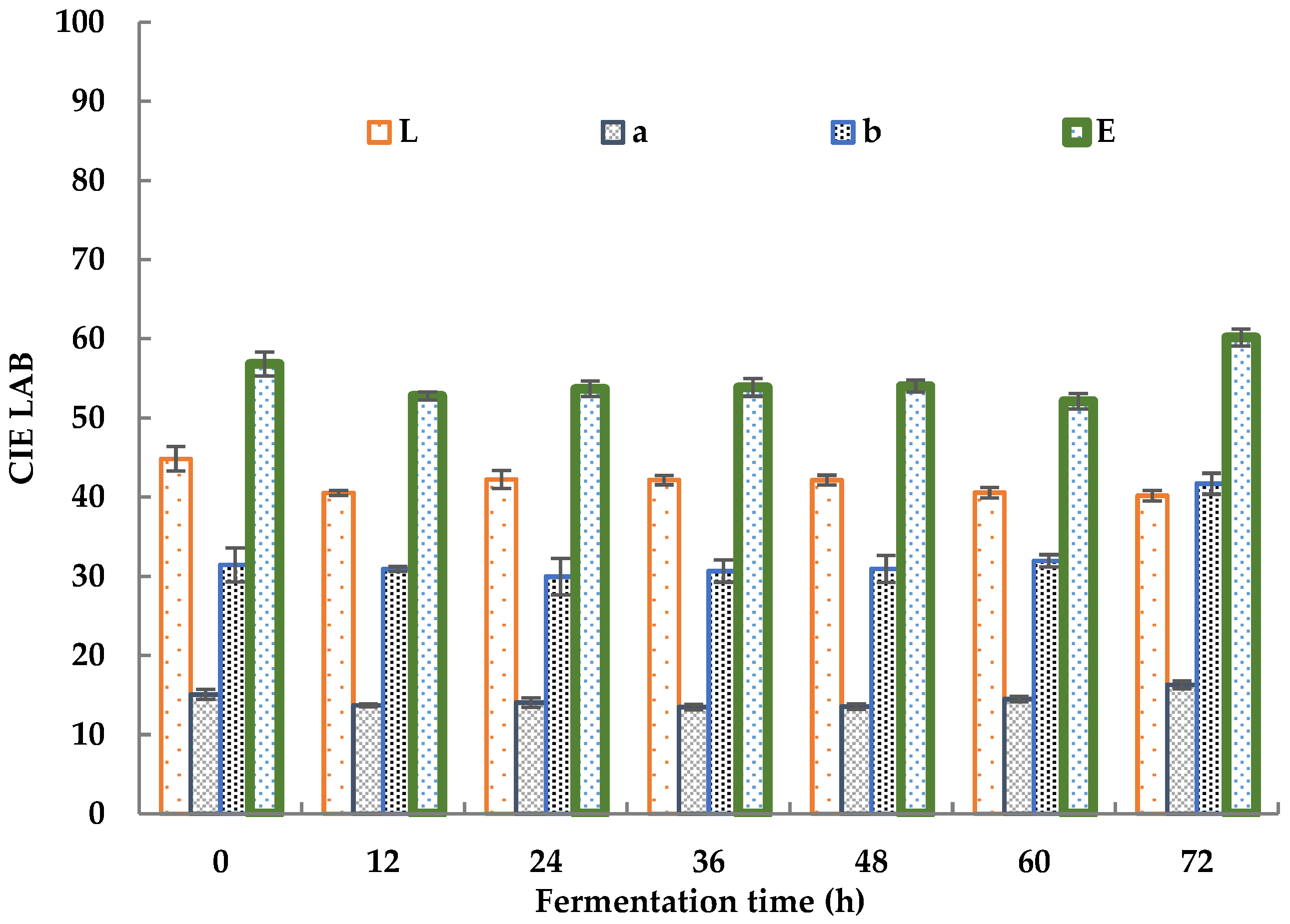
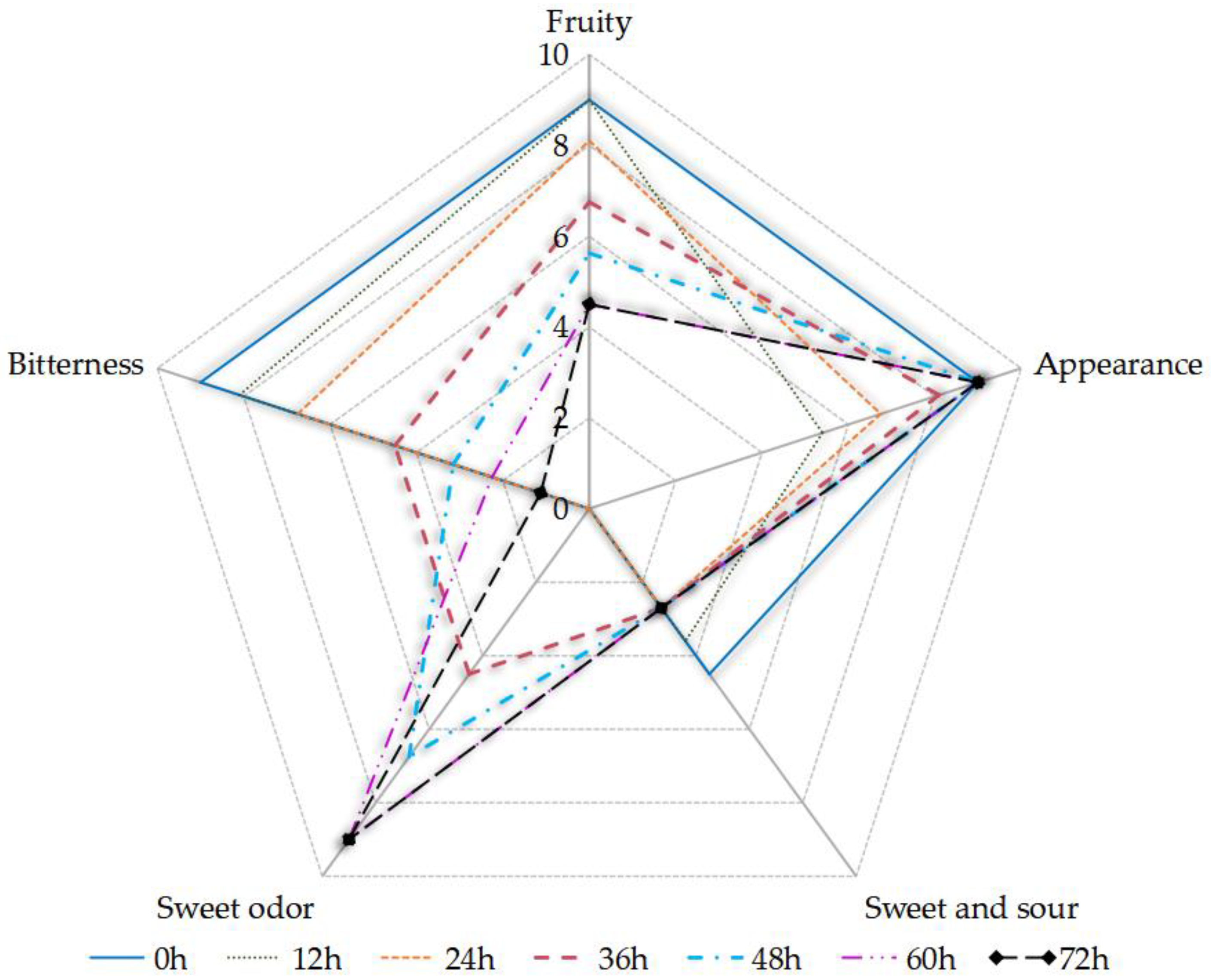
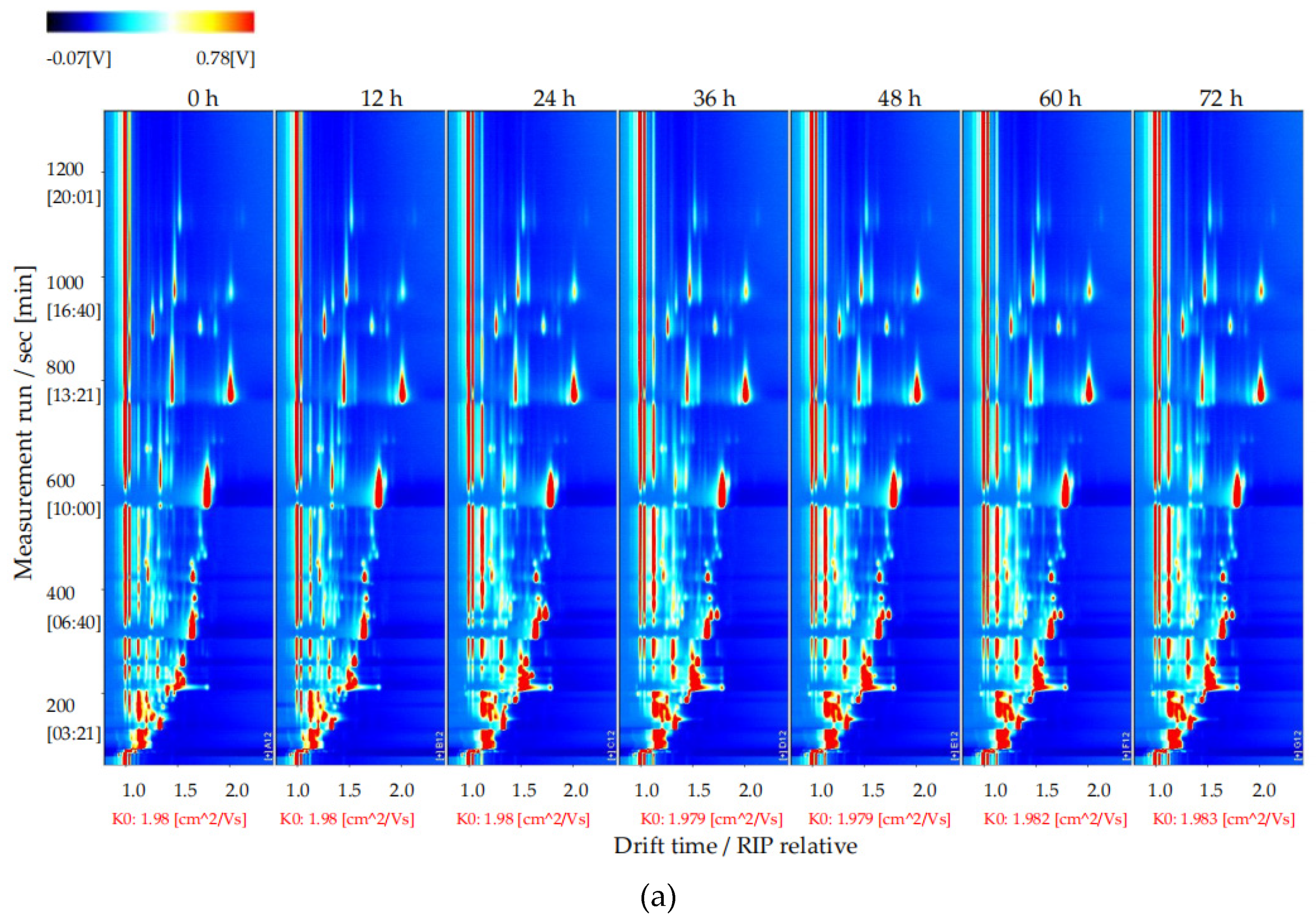
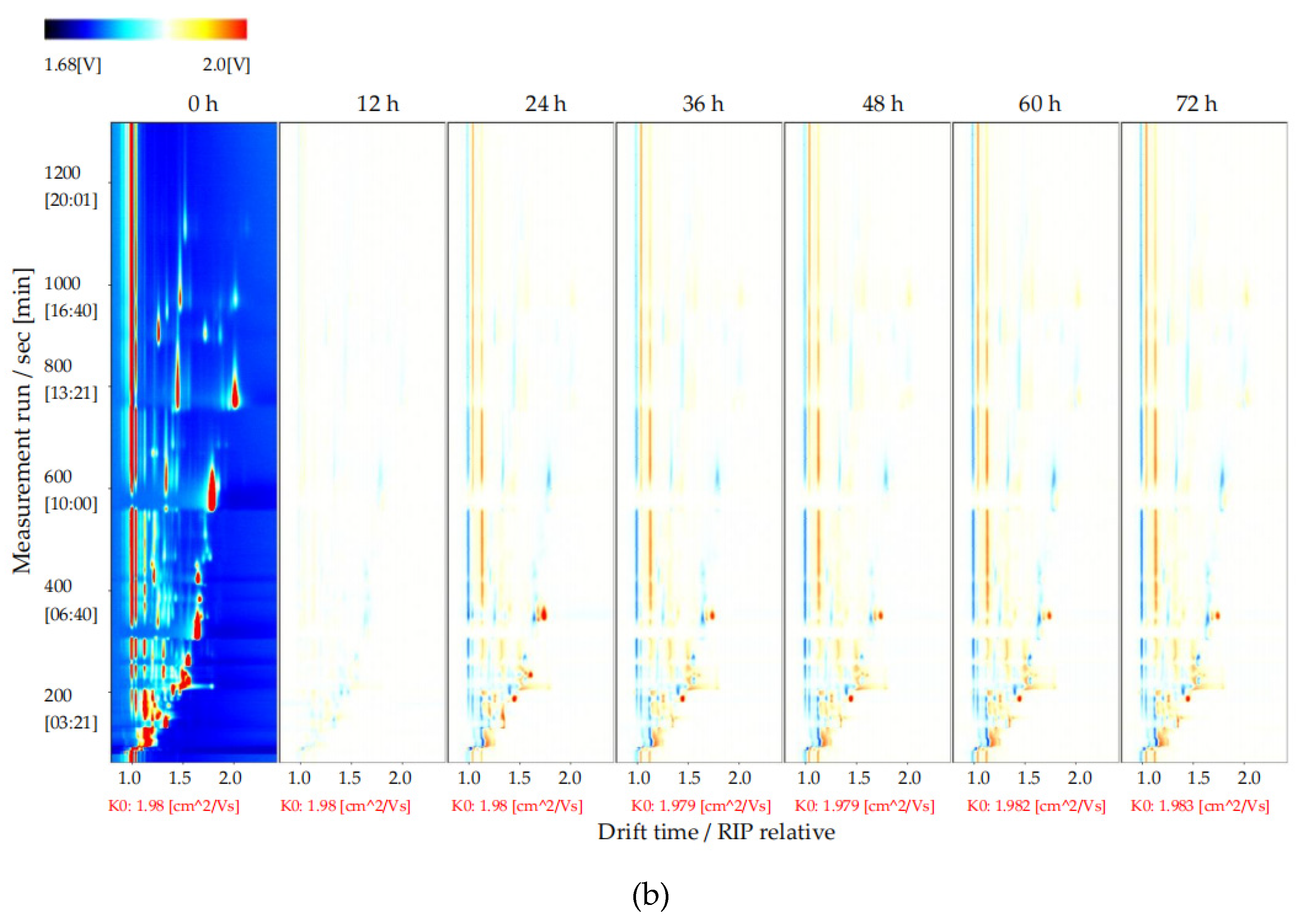

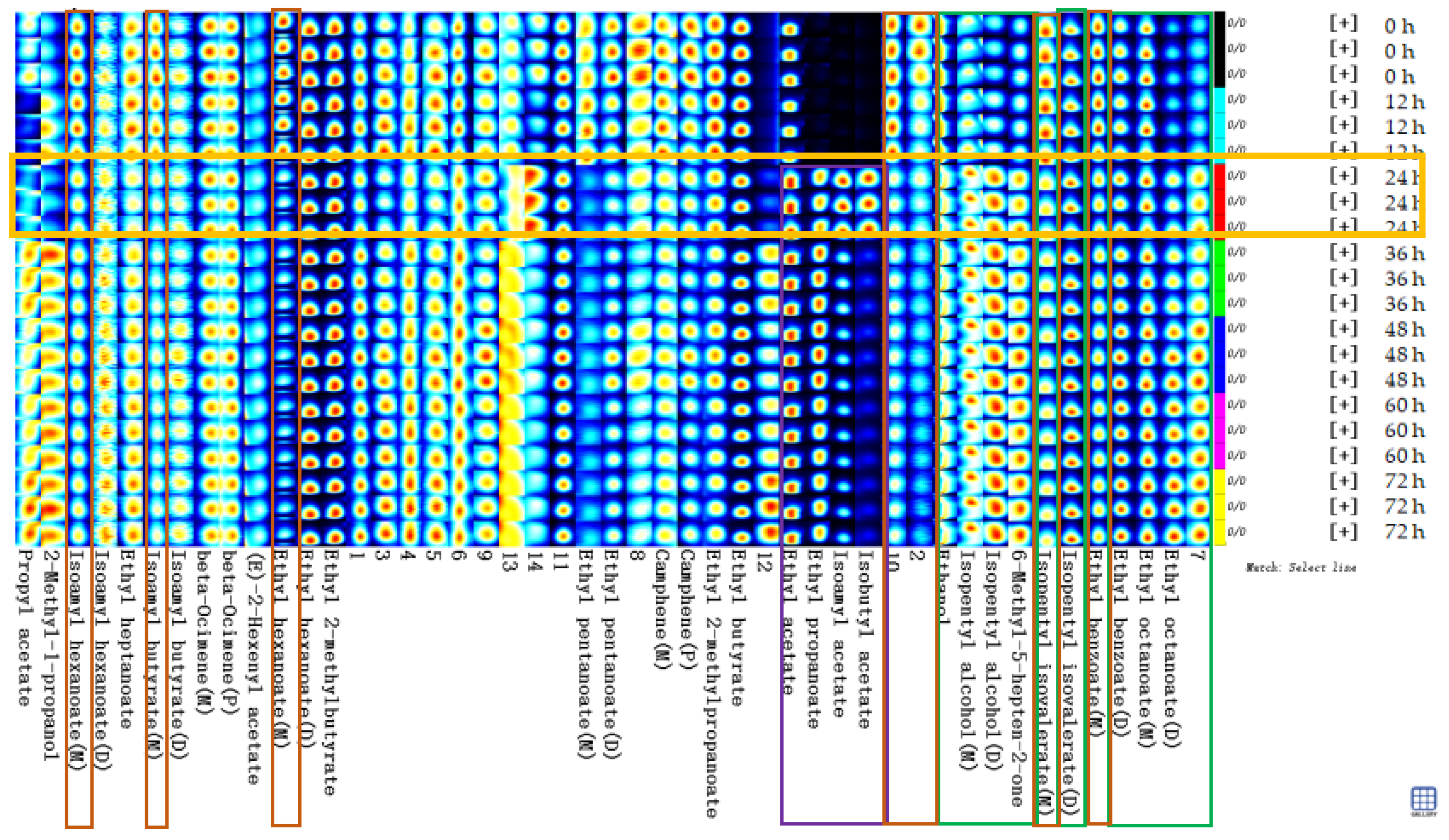
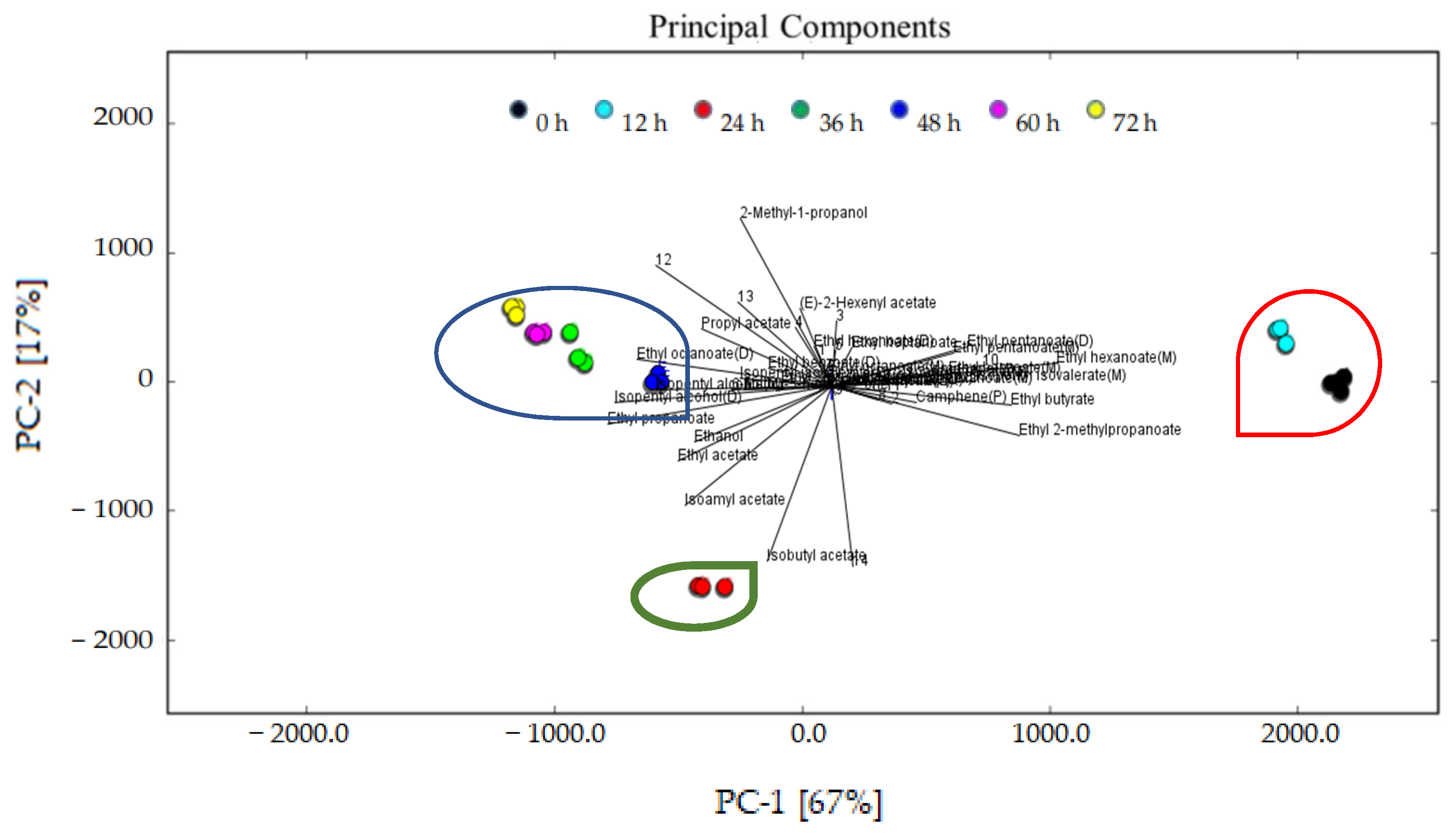
| Compound | CAS# | Formula | MW | RI | Rt [s] | Dt [a.u.] | |||
|---|---|---|---|---|---|---|---|---|---|
| Esters | Ethyl hexanoate (D) | C123660 | C8H16O2 | 144.20 | 1002.00 | 570.77 | 1.81 | ||
| Ethyl 2-methylbutanoate | C7452791 | C7H14O2 | 130.20 | 844.50 | 316.61 | 1.66 | |||
| Isopentyl isovalerate (D) | C659701 | C10H20O2 | 172.30 | 1102.80 | 769.43 | 2.03 | |||
| Ethyl acetate | C141786 | C4H8O2 | 88.10 | 581.90 | 138.26 | 1.34 | |||
| Ethyl butyrate | C105544 | C6H12O2 | 116.20 | 788.30 | 259.77 | 1.56 | |||
| Isopentyl isovalerate (M) | C659701 | C10H20O2 | 172.30 | 1107.40 | 780.01 | 1.45 | |||
| Ethyl hexanoate (M) | C123660 | C8H16O2 | 144.20 | 1002.00 | 570.77 | 1.34 | |||
| Ethyl octanoate (M) | C106321 | C10H20O2 | 172.30 | 1182.30 | 973.89 | 1.48 | |||
| Ethyl 2-methylpropanoate | C97621 | C6H12O2 | 116.20 | 744.40 | 222.02 | 1.56 | |||
| Ethyl benzoate (M) | C93890 | C9H10O2 | 150.20 | 1155.80 | 900.17 | 1.27 | |||
| Isopentyl hexanoate (M) | C2198610 | C11H22O2 | 186.30 | 1226.90 | 1111.21 | 1.53 | |||
| Ethyl benzoate (D) | C93890 | C9H10O2 | 150.20 | 1156.90 | 903.19 | 1.73 | |||
| Ethyl pentanoate (D) | C539822 | C7H14O2 | 130.20 | 898.00 | 383.07 | 1.68 | |||
| Ethyl octanoate (D) | C106321 | C10H20O2 | 172.30 | 1181.70 | 971.98 | 2.03 | |||
| (E)-2-Hexenyl acetate | C2497189 | C8H14O2 | 142.20 | 1021.70 | 605.03 | 1.86 | |||
| Propyl acetate | C109604 | C5H10O2 | 102.10 | 714.90 | 199.75 | 1.48 | |||
| Ethyl pentanoate (M) | C539822 | C7H14O2 | 130.20 | 901.20 | 387.93 | 1.27 | |||
| Isopentyl butanoate (M) | C106274 | C9H18O2 | 158.20 | 1065.00 | 687.81 | 1.41 | |||
| Ethyl propanoate | C105373 | C5H10O2 | 102.10 | 699.80 | 189.20 | 1.46 | |||
| Isopentyl acetate | C123922 | C7H14O2 | 130.20 | 873.40 | 350.65 | 1.75 | |||
| Ethyl heptanoate | C106309 | C9H18O2 | 158.20 | 1097.50 | 757.34 | 1.41 | |||
| Isopentyl hexanoate (D) | C2198610 | C11H22O2 | 186.30 | 1227.80 | 1114.23 | 2.13 | |||
| Isobutyl acetate | C110190 | C6H12O2 | 116.20 | 759.60 | 234.45 | 1.62 | |||
| Isopentyl butanoate (D) | C106274 | C9H18O2 | 158.20 | 1064.80 | 687.52 | 1.94 | |||
| Alcohols | Ethanol | C64175 | C2H6O | 46.10 | 432.70 | 94.29 | 1.13 | ||
| Isopentyl alcohol (M) | C123513 | C5H12O | 88.10 | 731.60 | 212.05 | 1.50 | |||
| Isopentyl alcohol (D) | C123513 | C5H12O | 88.10 | 731.10 | 211.68 | 1.79 | |||
| 2-Methyl-1-propanol | C78831 | C4H10O | 74.10 | 620.10 | 152.48 | 1.38 | |||
| Terpenes | Camphene (M) | C79925 | C10H16 | 136.20 | 941.00 | 452.78 | 1.20 | ||
| Camphene (P) | C79925 | C10H16 | 136.20 | 940.10 | 451.15 | 1.65 | |||
| Beta-Ocimene (M) | C13877913 | C10H16 | 136.20 | 1056.30 | 670.39 | 1.21 | |||
| Beta-Ocimene (P) | C13877913 | C10H16 | 136.20 | 1055.60 | 669.04 | 1.25 | |||
| Ketone | 6-Methyl-5-hepten-2-one | C110930 | C8H14O | 126.20 | 989.90 | 547.37 | 1.18 | ||
| Compound | Relative Contents (%) | Odor Description | |||||||
| Fermentation Period | |||||||||
| 0 h | 12 h | 24 h | 36 h | 48 h | 60 h | 72 h | |||
| Esters | Ethyl hexanoate (D) | 23.17 ±0.19 a | 22.80 ± 0.15 b | 19.39 ± 0.19 e | 21.26 ± 0.17 d | 20.87 ± 0.08 c | 20.76 ± 0.08 ef | 20.67 ± 0.03 f | apple peel, fruity * |
| Ethyl 2-methylbutanoate | 15.78 ± 0.14 a | 15.59 ± 0.07 b | 14.23 ± 0.11 c | 14.29 ± 0.06 d | 14.66 ± 0.03 c | 14.47 ± 0.01 d | 14.51 ± 0.02 d | Apple * | |
| Isopentyl isovalerate (D) | 6.98 ± 0.24 cd | 7.16 ± 0.08 d | 7.18 ± 0.11 b | 7.44 ± 0.07 c | 7.62 ± 0.09 a | 7.81 ± 0.05 ab | 7.89 ± 0.09 ab | Sweet, fruity, green, ripe, apple, jammy, tropical # | |
| Ethyl acetate | 6.47 ± 0.03 d | 5.98 ± 0.05 e | 9.43 ± 0.06 a | 8.36 ± 0.07 b | 8.01 ± 0.04 b | 8.11 ± 0.02 c | 8.13 ± 0.08 c | pineapple * | |
| Ethyl butyrate | 5.73 ± 0.08 a | 5.72 ± 0.02 b | 4.35 ± 0.06 d | 4.40 ± 0.07 e | 4.66 ± 0.01 c | 4.26 ± 0.01 f | 4.30 ± 0.01 f | apple * | |
| Isopentyl isovalerate (M) | 5.06 ± 0.02 a | 5.13 ± 0.01 b | 3.79 ± 0.07 c | 3.90 ± 0.07 d | 3.73 ± 0.01 d | 3.97 ± 0.08 d | 3.80 ± 0.03 e | Sweet, fruity, green, ripe, apple, jammy, tropical # | |
| Ethyl hexanoate (M) | 3.35 ± 0.15 a | 3.24 ± 0.02 b | 2.12 ± 0.04 c | 2.22 ± 0.02 cd | 2.05 ± 0.02 de | 2.07 ± 0.07 ef | 2.02 ± 0.01 f | apple peel, fruity * | |
| Ethyl octanoate (M) | 2.76 ± 0.11 c | 2.95 ± 0.03 bc | 2.84 ± 0.08 ab | 2.95 ± 0.04 bc | 2.98 ± 0.03 a | 3.10 ± 0.02 ab | 3.09 ± 0.00 ab | winey, sweet, apricot, banana, brandy, pear # | |
| Ethyl 2-methylpropanoate | 2.70 ± 0.03 b | 2.86 ± 0.01 a | 2.09 ± 0.01 c | 1.89 ± 0.01 d | 2.17 ± 0.08 c | 1.90 ± 0.01 d | 1.92 ± 0.01 d | rubber * | |
| Ethyl benzoate (M) | 2.66 ± 0.05 a | 2.67 ± 0.02 b | 2.14 ± 0.03 c | 2.16 ± 0.05 d | 2.09 ± 0.03 d | 2.16 ± 0.01 d | 2.18 ± 0.02 d | chamomile * | |
| Isopentyl hexanoate (M) | 1.04 ± 0.04 a | 1.05 ± 0.00 a | 0.83 ± 0.03 b | 0.89 ± 0.01 b | 0.85 ± 0.02 b | 0.90 ± 0.01 b | 0.87 ± 0.02 b | banana, apple, pineapple, green # | |
| Ethyl benzoate (D) | 1.01 ± 0.06 bc | 1.00 ± 0.02 c | 1.00 ± 0.05 b | 1.06 ± 0.02 bc | 1.13 ± 0.02 a | 1.18 ± 0.01 a | 1.19 ± 0.02 a | camomile * | |
| Ethyl pentanoate (D) | 0.98 ± 0.04 a | 0.86 ± 0.01 b | 0.66 ± 0.02 c | 0.65 ± 0.00 d | 0.82 ±0.01 b | 0.66 ± 0.01 d | 0.68 ± 0.01 cd | yeast, fruit * | |
| Ethyl octanoate (D) | 0.81 ± 0.05 d | 0.89 ± 0.01 d | 1.28 ± 0.04 c | 1.46 ± 0.03 b | 1.68 ± 0.07 a | 1.77 ± 0.02 a | 1.83 ± 0.04 a | winey, sweet, apricot, banana, brandy, pear # | |
| (E)-2-Hexenyl acetate | 0.78 ± 0.01 ab | 0.75 ± 0.01 c | 0.75 ± 0.01 b | 0.77 ± 0.01 c | 0.80 ± 0.00 a | 0.83 ± 0.02 ab | 0.82 ± 0.02 ab | Sweet, apple, banana ★ | |
| Propyl acetate | 0.39 ± 0.01 c | 0.21 ± 0.01 e | 0.26 ± 0.01 d | 0.54 ± 0.04 a | 0.46 ± 0.01 b | 0.50 ± 0.00 b | 0.54 ± 0.01 a | pear ★ | |
| Ethyl pentanoate (M) | 0.36 ± 0.00 b | 0.39 ± 0.01 a | 0.12 ± 0.01 c | 0.14 ± 0.01 c | 0.13 ± 0.01 c | 0.13 ± 0.00 c | 0.13 ± 0.01 c | yeast, fruit * | |
| Isopentyl butanoate (M) | 0.30 ± 0.01 a | 0.29 ± 0.00 b | 0.22 ± 0.00 cd | 0.23 ± 0.01 d | 0.24 ± 0.01 c | 0.25 ± 0.01 c | 0.24 ± 0.01 cd | green, apricot, pear, banana # | |
| Ethyl propanoate | 0.21 ± 0.01 e | 0.18 ± 0.01 f | 2.26 ± 0.01 c | 2.49 ± 0.02 b | 2.50 ± 0.01 a | 2.23 ± 0.01 d | 2.21 ± 0.02 d | yeast, fruit * | |
| Isopentyl acetate | 0.20 ± 0.00 f | 0.18 ± 0.01 f | 4.98 ± 0.03 a | 2.35 ± 0.02 b | 2.01 ± 0.00 c | 1.98 ± 0.01 d | 1.94 ± 0.01 e | banana * | |
| Ethyl heptanoate | 0.18 ± 0.00 d | 0.18 ± 0.00 d | 0.16 ± 0.00 e | 0.19 ± 0.01 c | 0.19 ± 0.00 bc | 0.20 ± 0.00 b | 0.21 ± 0.00 a | pineapple, cognac, rummy, winey # | |
| Isopentyl hexanoate (D) | 0.11 ± 0.01 b | 0.13 ± 0.01 ab | 0.11 ± 0.00 b | 0.13 ± 0.02 ab | 0.14 ± 0.01 a | 0.13 ± 0.00 ab | 0.14 ± 0.01 ab | banana, apple, pineapple, green # | |
| Isobutyl acetate | 0.05 ± 0.00 e | 0.06 ± 0.01 e | 1.45 ± 0.01 a | 0.34 ± 0.00 c | 0.34 ± 0.00 b | 0.29 ± 0.00 d | 0.29 ± 0.00 d | fruit, pple, banana * | |
| Isopentyl butanoate (D) | 0.04 ± 0.00 ab | 0.04 ± 0.00 ab | 0.04 ± 0.00 ab | 0.04 ± 0.00 b | 0.04 ± 0.00 a | 0.04 ± 0.00 ab | 0.04 ± 0.00 ab | fruity, green, apricot, pear, banana # | |
| Alcohols | Ethanol | 7.59 ± 0.02 e | 8.03 ± 0.02 d | 8.06 ± 0.04 a | 8.59 ± 0.03 ab | 8.31 ± 0.05 a | 8.64 ± 0.03 bc | 8.62 ± 0.01 c | sweet * |
| Isopentyl alcohol (M) | 2.04 ± 0.03 bc | 2.20 ± 0.06 a | 1.82 ± 0.03 d | 2.10 ± 0.01 c | 2.02 ± 0.03 c | 2.19 ± 0.01 ab | 2.16 ± 0.02 bc | whiskey, malt, burnt * | |
| Isopentyl alcohol (D) | 0.23 ± 0.01 e | 0.29 ± 0.00 d | 0.49 ± 0.01 c | 0.57 ± 0.00 b | 0.54 ± 0.01 b | 0.59 ± 0.00 a | 0.60 ± 0.01 a | ||
| 2-Methyl-1-propanol | 0.18 ± 0.01 d | 0.23 ± 0.02 c | 0.14 ± 0.01 e | 0.32 ± 0.00 ab | 0.30 ± 0.00 b | 0.34 ± 0.00 ab | 0.34 ± 0.01 a | wine, solvent, bitter * | |
| Terpenes | Camphene (M) | 0.43 ± 0.01 a | 0.37 ± 0.01 b | 0.31 ± 0.02 c | 0.28 ± 0.00 e | 0.35 ± 0.00 b | 0.30 ± 0.00 de | 0.30 ± 0.00 d | camphor * |
| Camphene (P) | 0.48 ± 0.01 a | 0.49 ± 0.02 a | 0.36 ± 0.00 b | 0.35 ± 0.00 c | 0.36 ± 0.00 b | 0.34 ± 0.01 c | 0.35 ± 0.00 c | ||
| Beta-Ocimene (M) | 0.36 ± 0.02 a | 0.37 ± 0.01 a | 0.31 ± 0.01 b | 0.31 ± 0.00 cd | 0.31 ± 0.01 bc | 0.30 ± 0.00 d | 0.31 ± 0.00 cd | Citrus, tropical, green, woody # | |
| Beta-Ocimene (P) | 0.29 ± 0.01 ab | 0.30 ± 0.00 a | 0.26 ± 0.01 c | 0.28 ± 0.00 c | 0.27 ± 0.00 c | 0.29 ± 0.01 bc | 0.29 ± 0.00 c | ||
| Ketone | 6-Methyl-5-hepten-2-one | 0.25 ± 0.01 d | 0.28 ± 0.01 d | 0.44 ± 0.01 c | 0.47 ± 0.01 c | 0.51 ± 0.01 b | 0.54 ± 0.01 ab | 0.55 ± 0.00 a | pepper, mushroom, rubber * |
Publisher’s Note: MDPI stays neutral with regard to jurisdictional claims in published maps and institutional affiliations. |
© 2022 by the authors. Licensee MDPI, Basel, Switzerland. This article is an open access article distributed under the terms and conditions of the Creative Commons Attribution (CC BY) license (https://creativecommons.org/licenses/by/4.0/).
Share and Cite
Wu, D.; Xia, Q.; Cheng, H.; Zhang, Q.; Wang, Y.; Ye, X. Changes of Volatile Flavor Compounds in Sea Buckthorn Juice during Fermentation Based on Gas Chromatography–Ion Mobility Spectrometry. Foods 2022, 11, 3471. https://doi.org/10.3390/foods11213471
Wu D, Xia Q, Cheng H, Zhang Q, Wang Y, Ye X. Changes of Volatile Flavor Compounds in Sea Buckthorn Juice during Fermentation Based on Gas Chromatography–Ion Mobility Spectrometry. Foods. 2022; 11(21):3471. https://doi.org/10.3390/foods11213471
Chicago/Turabian StyleWu, Dan, Qile Xia, Huan Cheng, Qichun Zhang, Yanbin Wang, and Xingqian Ye. 2022. "Changes of Volatile Flavor Compounds in Sea Buckthorn Juice during Fermentation Based on Gas Chromatography–Ion Mobility Spectrometry" Foods 11, no. 21: 3471. https://doi.org/10.3390/foods11213471
APA StyleWu, D., Xia, Q., Cheng, H., Zhang, Q., Wang, Y., & Ye, X. (2022). Changes of Volatile Flavor Compounds in Sea Buckthorn Juice during Fermentation Based on Gas Chromatography–Ion Mobility Spectrometry. Foods, 11(21), 3471. https://doi.org/10.3390/foods11213471







